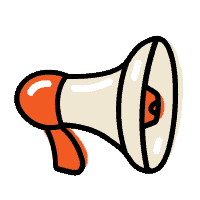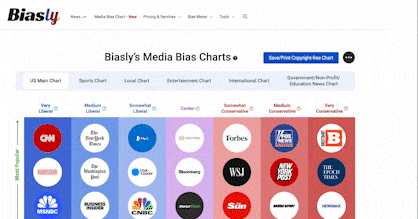
The Holocaust was one of the most horrific atrocities in recorded human history. Nazis in Germany used propaganda to influence the general public to facilitate it. We can learn a lot about how people can manipulate the news and media from Nazi propaganda. Many biased media outlets use the same propaganda techniques, messages, and media to influence the public. This article examines the modern implications of propaganda, its ties to biased news, and its historical roots. It also discusses the core elements of Nazi propaganda and the valuable lessons we can learn from its use.
Historical Context
The Nazi Party emerged in 1920 as a rebranding of an earlier iteration of a group founded in 1919. However, at the time, they were not particularly popular. It was not until the Great Depression that the Nazi Party started gaining traction. Germany was in a state of turmoil due to the economic crisis and the despair from World War I. This left many Germans susceptible to the grand promises of the Nazi Party and its leader, Adolf Hitler. The Nazis sympathized with the pain and rage of Germans who felt left behind and forgotten by their country.
Hitler was appointed as the Chancellor of Germany in 1933. During this year, a Dutch communist started a fire in a government building. Hitler convinced the president at the time that this indicated a national emergency on the grounds that enemies were infiltrating Germany. During this “national emergency,” the government suspended many basic freedoms and rights. This laid the groundwork for an imminent Nazi takeover. When the president died in 1934, Hitler took complete control of the government and the military. Hitler maintained his power in a handful of ways. One of these was establishing a federal department of propaganda.
What is Propaganda?
So what is propaganda, exactly? Propaganda is the distribution of information or an argument in an attempt to influence people’s opinions. Oftentimes, this information or argument is misleading or inaccurate, though not always.
This definition of propaganda seems to cross over with misinformation, persuasion, and biased news, though, doesn’t it? What is the difference? All three of these things can be a part of propagandistic efforts, but they don’t have to be. Misinformation can be accidental, and propaganda can be wholly grounded in truth. Communication experts Jowett and O’Donnell wrote in Propaganda and Persuasion that persuasion is “interactive and attempts to satisfy the needs of both persuader and persuadee.” Most propaganda does not allow for a response from or conversation with a dissenter.
Like biased news, propaganda typically presents a specific angle or stance. However, the intention of propaganda is not always to “inform” in the way that news is. Additionally, bias in the news can be unintentional; propaganda is always created intentionally. Nonetheless, biased reporting is a key aspect of propaganda. This is something to watch out for, especially as unbiased news sources become harder to find. (Helpful hint: you can always use Biasly’s Media Bias Rating List to know what kind of news you are consuming!)
Propaganda can be extremely powerful. It certainly was during the rise and rule of the Nazi Party in Germany. Let’s look at exactly how the Nazi Party used propaganda to propel their campaigns.
Messages in Nazi Propaganda
Examining Nazi propaganda and promises of national revitalization reveals several themes.
Antisemitism
First and foremost, antisemitism was the leading theme of Nazi propaganda. Antisemitism is the prejudice against Jewish people. This was an effort to assert the supremacy of others, especially the Aryan people, over the Jewish people. Aryan people, as Nazis characterized them, are a mythical race. Those considered Aryan people were white, non-Jewish individuals, usually with Nordic ancestry, blue eyes, and blond hair.
Oftentimes, Nazi propaganda described or depicted exaggerated physical features that the Nazis deemed “Jewish.” This kind of propaganda tended to associate Jewish people with the control of money or greediness, a long-standing stereotype. This was a particularly incendiary stereotype to draw on in a period when many Germans were deeply struggling economically. Nazi propaganda also associated Jewish people with “impurity” and claimed that they were “uncivilized.” Other stereotypes Nazis perpetuated about Jewish people are that they conspire together as global overlords and participate in blood libel. Neither of these are new, but the Nazis weaponized them for their own political uses. The Rothschilds, an influential Jewish family of bankers, personified Jewish people as a stand-in for world dominators. This family was painted as conniving and avaricious power-seekers. The Nazi Party invoked these theories about the Rothschilds to place blame for global and national events on Jewish people. Blood libel is the conspiracy theory that Jewish people participate in rituals that require the sacrifice of Christians, especially children. Nazis also adopted this old theory in their propagandistic efforts.
These stereotypes are long-lasting, and they did not stop with the Nazi Party. Unfortunately, this kind of prejudice continues today, and these myths still linger. Sometimes, it can lead to public harassment and even violence against Jewish people. Antisemitic incidents increase in number every year. In 2024, there were nearly 10,000 recorded antisemitic incidents in the United States. This represents a 5% increase from 2023 and an 893% increase over the past decade. This isn’t just a trend in the United States, either. The global count of antisemitic incidents in 2024 increased by 107.7% from 2023, now up to 6,326 incidents.
Anti-Communism
Anti-Communism was another popular sentiment in Nazi propaganda. The radically right-wing Nazi stance saw Communism, a far-left ideology, as a dangerous challenge. Its focus on class solidarity undermined Nazi preoccupation with racial supremacy. The first Nazi concentration camp explicitly targeted Communists, rather than Jewish people.
Still, anti-communism was closely related to antisemitism in Nazi propaganda. The United States Holocaust Museum noted that for Nazis, “communism was recast as Judeo-Bolshevism.” Judeo-Bolshevism was based on the claim that communism is essentially a Jewish conspiracy aimed at destroying German ways of life. Various Nazi propaganda images depict this connection, including the one below.
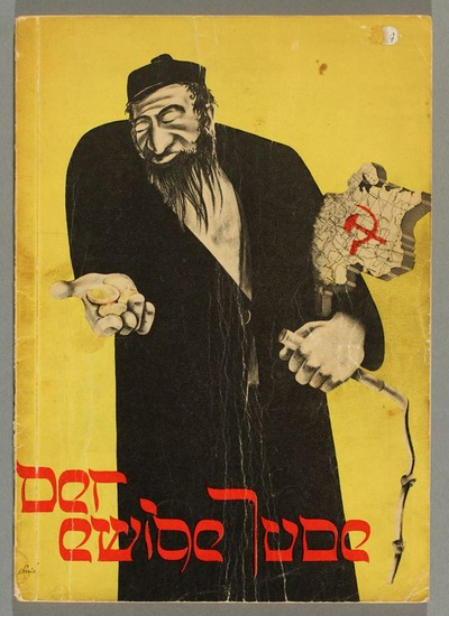
Source: United States Holocaust Museum
This particular piece of propaganda reads: “The Eternal Jew.” It depicts a man holding coins and a whip in his hands while standing next to the symbol for communism. This type of messaging, though referencing opposition to communism, is redirecting fear of communist threats to fear of Jewish people. By using the more approachable lens of anti-communism, Nazis can promote violent antisemitism.
The U.S. has also had a rocky history with anti-communist sentiment. Famously, throughout the 1900s, especially the 40s and early 50s, America experienced the Red Scare. After anarchist bombings and the discovery of Soviet Union spies, the nation underwent a witch hunt for alleged communists. This resulted in the blacklisting and detainment of celebrities and artists, the firing of workers based on mere suspicions, rampant surveillance of leftist groups, the condemnation of protests, and more. America’s history, too, shows the dangers of taking ideological opposition too far. While not a violent government takeover like in Nazi Germany, civil liberties in America were still compromised.
However, opposing an ideology certainly is not inherently wrong. You can find more and less extreme forms of opposition to communism everywhere, including America. Nowadays, there are plenty of well-articulated think-pieces, studies, and policy debates on issues with communism. Politicians like President Joe Biden have called communism a “failed system,” while conveying support for pro-democracy protests in Cuba. President Donald Trump has also given his view on Marxism and communism as threats to democracy. It is not uncommon to see these more practical forms of anti-communism today that express a value set and don’t undermine anyone’s rights.
Nationalism
Another major theme in the propaganda was nationalism. For Nazis, Nazi propaganda and national unity went hand-in-hand. Feelings of superiority over other countries often accompanied the nationalist devotion to one’s nation. To garner broad support for the movement, propaganda included ideas of family, duty to neighbors, and the Nazi Party’s promises to take care of the German people.
The Nazi Party actively supported the “stab in the back” myth as part of their nationalist efforts. This myth is the idea that Germany lost its power because it was betrayed by enemies (like Jewish people), rather than through natural defeat. This theory fostered nationalist sentiment because it prompted a wave of distrust of other countries and nostalgia for a strong pre-war Germany. The Nazi party capitalized on this feeling, promising a return to a once-great Germany.
There are nationalist politicians and parties worldwide. In 2018, Politico reported on Trump’s declaration, “I’m a nationalist,” where he urged people to “use that word.” Modern Diplomacy noted that support for nationalist parties emerged in several European countries this year, like Poland, Germany, the Netherlands, and Romania. “Extreme nationalist” comments from Chinese users online resulted in the government’s condemnation of rising xenophobia.
Other prominent themes in Nazi propaganda were pro-war sentiments, conspiracy theories, and Social Darwinism. Social Darwinism posits that people who attain and maintain power are biologically superior to those without it. Of course, for the Nazi Party, this meant that Aryans were inherently superior to Jewish people and other non-white ethnicities.
Nazi propaganda frequently communicated all of these messages and more.
Forms of Nazi Propaganda
Nazi propaganda was distributed in a variety of ways to reach the maximum number of people. Posters and pictures were plastered throughout cities, buildings, and even in special museum exhibits sponsored by the party itself. Nazi propaganda leaflets and literature were also commonly dispersed. The Nazi party frequently engaged in book burnings where they destroyed literature deemed offensive to the party. One of these events was the first book burning in Munich on May 10th, 1933. 3,000 people walked through the streets to burn books and chant Nazi slogans and songs. According to organizers, 70,000 people attended to watch.
Nazi party leaders and academics also frequently gave speeches. These speeches were delivered in various settings, including broadcasts on state-approved radio stations. The Nazi party maintained a tight grip on news and media outlets and utilized them as another medium for propaganda. Political bias in the news was not just commonplace– it was mandated. We are no strangers to bias in the media today, and how pervasive it is. Being proactive in identifying political bias is of both historical and modern importance. When you read the news, referring to resources like a media bias chart or bias checklists can be helpful to combat this phenomenon.
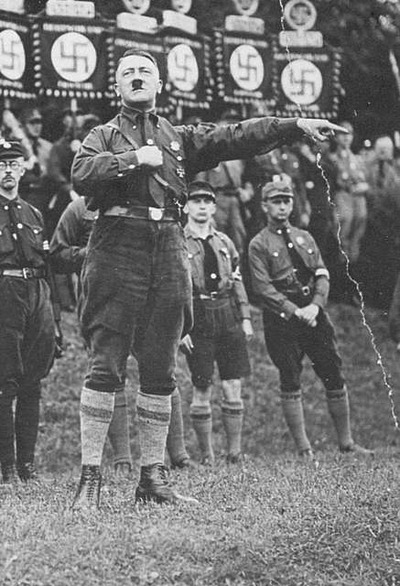
Source: Public domain
Hitler giving a speech in Nuremberg.
The use of those more traditional forms of propaganda is pretty well-known. However, cultural propaganda was just as common. Examples of Nazi propaganda in German culture include songs, plays, toys, and sporting events. Nazi propaganda in movies was also widespread and many of these films are still analyzed today. This “soft propaganda” can be less overt and manages to slowly and subtly work Nazi messages into public entertainment.
Target Audiences
The Nazi Party intended to reach people all over the world. However, they focused their propaganda on a few key audiences. Of course, much of the propaganda targeted white Aryan Germans. This is the group most heavily championed by the Nazi Party and the most likely to sympathize with their beliefs. Nazis reached out to this demographic by emphasizing their physical and intellectual superiority. They also claimed that this group was in constant danger and required protection.
Another significant audience was youth and children. Authoritarian regimes often target young people because they tend to be malleable. It is easier to teach someone new rhetoric who hasn’t yet formed attachments to old ways of thinking. Nazis frequently represented children as heroes and fighters in their propaganda. 5.4 million children were members of the Hitler Youth organization by 1939.
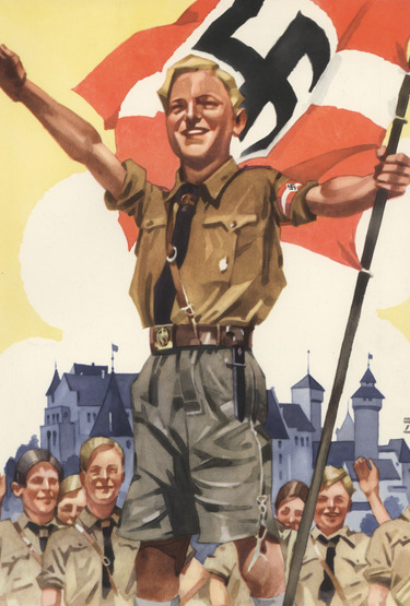
Ludwig Hohlwein Schmucktelegramm Hitlerjugend HJ 1936:
“Hitlerjunge mit Fahne vor Nürnberger Burg”
This tactic of targeting young people is not out of the ordinary. Social media is a rising instrument of political campaigns to reach youth. Around half of young adults (18-29) cite staying politically informed as a reason for using TikTok, according to the Pew Research Center. Leading up to the 2024 presidential election, Time reported that Kamala Harris’s campaign honed in on social media. They posted memes, gave hundreds of content creators credentials at the Democratic National Convention, and established a presence on multiple platforms. Similarly, AP News noted that Trump’s political campaign has made an effort to speak and appear with conservative influencers.
This makes young people particularly vulnerable to media bias and political propaganda. Biasly’s media literacy course is equipped to help educators guide students in navigating this tricky terrain. In the age of social media, learning to steel ourselves against these techniques is necessary.
Techniques in Nazi Propaganda
We have talked about what messages Nazi propaganda sent, where they sent them, and who they were for. Now, let’s look at how exactly they got their messages across.
Symbolism
A swath of highly identifiable symbols marked the Nazi regime. Nazi propaganda posters made frequent use of them. The swastika is the most well-known of these, and its meaning clarifies why people used it. In the 1870s, a German historian discovered an ancient archaeological site in the Mediterranean that was full of swastikas. A variation of the swastika had been prominent in Hinduism for centuries. So, German nationalists used this discovery as proof of the “master” Aryan race that conquered other non-white peoples.
Another symbol the Nazis used in their propaganda was the Black Sun, also known as Sonnerand. This symbol was originally found in Norse and Celtic cultures. Its use by the Nazis represents the “pure-blooded” Nordic heritage that the Nazis favored.

Source: Public domain
Swastika symbol.

Source: Public domain
An iteration of the Black Sun symbol.
Symbols are powerful tools in propaganda because they easily associate people, places, and things with the group that uses them. Seeing a swastika or a Black Sun immediately indicates the Nazi Party approved something. At the same time, the meaning behind these symbols is transmitting the narratives and messages that the group wants you to believe.
Political symbolism is not inherently malicious. It has had a key place in the United States, too. During World War I, Uncle Sam was a popular symbol used to encourage enlistment in the military. He personified the American government and aimed to remind citizens of their duty to him. In the 70s, his symbol was used by anti-war protestors to remind the government of its duty to its soldiers.
Repetition and Slogans
The Nazi Party used catchy phrases that they repeated to get across their main points. These slogans were punchy and easy to remember. Nazis were able to boil down their platform succinctly and memorably.
Some of these slogans were “Work and Bread,” “Blood and Soil,” and “One People, One Empire, One Leader.” Once people get behind them, then the brutality of the Nazi methods to achieve these goals reveals itself.
Political slogans are still prevalent today. Notable examples include President Barack Obama’s “Yes We Can” and President Donald Trump’s “Make America Great Again.”
“The Enemy”
The idea of “the enemy” is a particularly hostile technique. It is a tool that is still very popular today. As we discussed earlier, the people that Nazis painted as enemies were mainly Jewish people and Communists. It can be hard to motivate people to unite under a common goal to work towards. However, it can be very effective to mobilize people against a perceived threat.
The idea of an enemy allowed the Nazi Party to justify severe human rights violations. It united people under a fear of invasion. “The enemy” can also divide a nation. The construction of “the enemy” is very prevalent in today’s polarized America. A poll from 2022 conducted by NBC News found that the vast majority of Democrats and Republicans see each other’s politics as likely to destroy America.

Graphic created by Biasly for illustrative purposes)
Who is deemed an enemy of the nation is a highly political decision. It is important to be aware of who we consider a threat and why. You can be on the lookout for this tactic by analyzing the reliability and bias of the news you consume. Tools like Biasly’s News Check Chrome Extension can help you weed out dangerous and misinformative news in real time.
Other techniques used by the Nazi party in their propaganda include emotional appeals and media control. Nostalgia made frequent appearances, evoking memories of “better” times when
the nation was strong and prosperous. The Nazi Party offered safety and protection, contrasting the panic and danger of the outside world.
We see nostalgia used often nowadays, too. For example, progressive attempts to pass climate legislation called the “Green New Deal” explicitly reference President Franklin Roosevelt’s New Deal. The New Deal was a series of radical social reforms to mitigate the effects of the Great Depression. The Green New Deal presents itself as a series of energy and environmental reforms in the face of the climate crisis.
Nazi propaganda and censorship also went hand-in-hand. To keep their message at the forefront, they had to eliminate opposing stances. It was forbidden to report on the Nazi concentration and death camps. The government passed a law on journalism that read: “Editors are especially bound to keep out of the newspapers anything which: (…) tends to weaken the strength of the German Reich.”
Why Does This Matter?
Though powerful and effective, there was resistance to Nazi propaganda, too. Occasionally, underground resistance groups distributed anti-Nazi pamphlets. But the reason it is so important to learn about propaganda is so we can prevent these horrors in the first place. When we learn about the characteristics of things like Nazi propaganda, we stop history from repeating itself. Knowing the tools used to commit atrocities takes some of their power away. You can’t fight what you don’t understand.
While propaganda is all around us, we don’t have to succumb to everything we see. There is a lot we can take away from historical uses of propaganda. Nazi propaganda reminds us to look out for the revision of history and the creation of violent myths. To be mindful of narratives about enemies and outside threats that are constantly plotting against the in-group. To look beyond the surface of symbols and slogans. By working to understand these histories and improve our media literacy skills, we give our futures a better chance. When we know better, we can do better.
























